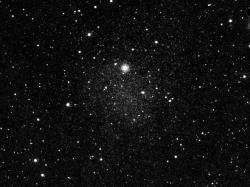RAVE-ING Success As Generations Of Astronomers Survey The Stars

Cambridge PhD student is following in his great-great-grandfather's footsteps by helping to measure the speeds of up to one million stars passing near the Sun – a huge advance on the efforts of his ancestor who was able to measure the speeds of only 100 stars over a century ago.
"The speeds of stars reveal where they were born," said George Seabroke, a graduate student at the Institute of Astronomy in Cambridge. "We're trying to find out whether stars in our own Milky Way galaxy were actually made here or whether some of them existed in other galaxies, before becoming part of our Galaxy. Such a large survey wasn't possible in my great-great-grandfather's era."
Current galaxy formation theories predict that some of these other galaxies were cannibalised by the Milky Way a long time ago as it was growing, leaving their very old stars where we see them today. Uncovering these fossil remains will reveal the history of our Galaxy – a practice known as Galactic Archaeology.
In order to undertake a survey of this scope, astronomers are participating in the RAdial Velocity Experiment (RAVE). This ambitious spectroscopic survey is intended to measure, over the next few years, radial velocities and stellar atmosphere parameters (temperature, metallicity, surface gravity) of up to one million stars passing near the Sun.
For the last three years, RAVE has been using the unique capabilities of the ‘six degree field' (6dF) multi-object spectrograph on the 1.2-m UK Schmidt Telescope of the Anglo-Australian Observatory, sited at Siding Spring Observatory in New South Wales, Australia.
This instrument is capable of obtaining spectroscopic information for as many as 150 stars at once, over a full six degree diameter, equivalent to 12 full Moons lined up in row. This is more than one hundred times larger than typical spectrographs. The combination of area and number of simultaneous spectra allows this unprecedented survey to be feasible.
Today, the leader of RAVE, Professor Matthias Steinmetz of the Astrophysical Institute Potsdam (AIP) in Germany, announced the first data release from the experiment to the astronomical community at the Local Group Cosmology meeting in Aspen, Colorado, USA. The data release includes 25,000 stars from the first year of RAVE (over 80,000 stars have been observed to date).
"RAVE will run for several more years, and the full RAVE survey will provide a vast resource of stellar motions and chemical abundances, allowing us to answer fundamental questions of the formation and evolution of our Galaxy," said Professor Steinmetz.
George Michael Seabroke is part of the international team of astronomers working on RAVE. His great-great-grandfather, George Mitchell Seabroke, was an early pioneer in measuring the speeds of stars at the Temple Observatory, Rugby School, Warwickshire, in the 1880s. His competitor at the time was Carl Hermann Vogel, who was the first to measure a star speed from a photograph in 1888. Vogel was the director of the institute that later on became the AIP in Germany. Now, Professor Matthias Steinmetz, the leader of RAVE, is the AIP director. The current Seabroke generation is now collaborating with the AIP via RAVE.
George Senior could only look at the light spectrum of one star at a time through the telescope eyepiece. RAVE's telescope looks at an area of sky more than 100 times greater than the full Moon. It has 100 optical fibres, each acting like an eyepiece that can be automatically pointed towards a star. This enables RAVE to simultaneously receive light from lots of stars so that it can survey the Southern Sky at a rate many times faster than the extremely patient Mr. Seabroke Senior!
Source: Royal Astronomical Society (RAS)















